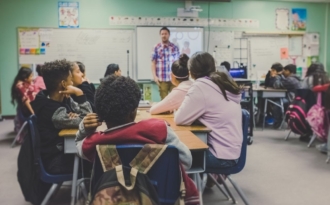Teachers want to encourage higher-level thinking skills among their students. Many fear technology can make students passive consumers of the vast amounts of information they encounter, instead of encouraging them to think critically.
Distraction is another concern. A Gallup poll found that nearly 30 percent of teachers believe the use of digital devices in school is harmful — rooted in the fear that these devices can be distracting rather than contributing to critical thinking.
Though legitimate concerns, teachers need to shift their thinking. Although students are certainly consuming a ton of information online, they’re also using the tools at their disposal to create their own content and applying thinking skills to analyze media sources.
The teacher’s responsibility is to be familiar with the tools students are using and how they’re using them, so they can bring these tools into the classroom.
Pro Tip
Bring tech into your classroom with free online education forms and quizzes your students will love!

How can teachers harness the tech students use?
The gap between students’ perspective on technology and that of their teachers is vast. Teachers often feel uncomfortable teaching tech to students, because students are often more capable of teaching technology to them.
While teachers may know how to use Facebook messenger and Twitter, they might not realize that students are already ahead of them, using Google Docs as a chat tool in class, says tech writer Taylor Lorenz. “As more and more laptops find their way into middle and high schools, educators are using Google Docs to do collaborative exercises and help students follow along with the lesson plan. The students, however, are using it to organize running conversations behind teachers’ backs,” she explains.
It can be scary when your students know more about a tool than you do, says teacher Tricia Ebner. A colleague of hers addressed this discomfort by allocating regular time in her science class with students to explore technology tools together and teach each other how to use them.
Working with technology might be more effective when students teach each other and the teacher. More information is shared, and students learn more when they have to explain something to their peers says Nicole Krueger at the International Society for Technology in Education (ISTE). Students learn more when collaborating because they are practicing their higher-level thinking skills. They apply knowledge, evaluate strategies, and analyze different techniques.
While many teachers feel comfortable using technology passively in the classroom, rather than letting students engage with the tools, this prevents kids from learning digital literacy. Indeed, it actually stops them from using their higher-level thinking skills.

Use digital tech for more than just busywork
Technological solutions ebb and flow. Once you master a tool that your students love, it might become outdated or be purchased by another tech company.
Some key characteristics of the technology that you choose should stay consistent, no matter what’s on the market at the time. You shouldn’t use technological tools in the classroom just to move busywork from paper to the screen. That doesn’t accomplish anything new or teach your students to think differently about the material.
Instead, tech should encourage students to create, communicate, and collaborate. These are the higher-level thinking skills that your students need and that technology naturally brings out in them, better than pen and paper.
“I was visiting a school recently, and saw students use digital devices to make genome maps of the indigenous plant life around their campus. It was a fantastic project,” says Richard Culatta, CEO at ISTE. “But too often I see students in a computer lab reading some stuff on the screen, then clicking next, next, next. If you’re going to help students own their own learning and become creators and collaborators, then you can’t take the powerful tools we have and just do the same thing we’ve always done, but on a screen.”
Key to higher thinking skills in today’s context is the ability to decipher sources and identify correct information on the internet. Former English teacher Eileen Murphy founded ThinkCERCA, a flexible literacy framework that helps students engage in critical thinking. She says kids are exposed to a striking amount of misinformation online today. This is why she developed a tool teachers can use to give individualized lesson plans that elicit critical thinking skills in English, social studies, science, and math.
“Try to choose technologies that support interactivity, critical thinking, and problem solving,” suggest professors Christian Moro and Kathy Mills. Examples include educational and explorative online games, websites that encourage problem solving, writing basic code, and creative expression.
The bottom line is that students want to think critically — all teachers have to do is give them the tools to do so.














Send Comment:
1 Comments:
More than a year ago
Great Article on Creativity Thinking. Thanks for great info.